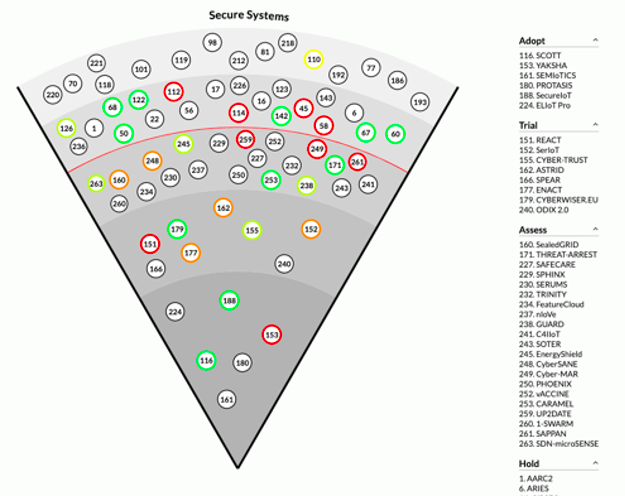The EU Project radar provides an accurate and unique birds eye view of the European R&I cybersecurity landscape of EC-funded projects. The backbone of the EU Project Radar are six segments which represent the Cybersecurity R&I taxonomy as defined by the University of Oxford. These are described below.
When populating the radar, a project's classification according to the taxonomydetermines the sector in which the project's radar "blip" (a small circle) will be placed.

By clicking on the radar segments, you can dive deeper into each theme and get a clearer picture of the different projects that have been funded and their relative maturity. Each blip represents a project and you can click on them for more information. Projects are also listed on the right of the screen and information can be accessed there too by clicking on the project name.
Use the JRC Taxonomy filter to identify projects working on a particular technology or vertical sector.
The Cyberwatchng.eu project uses the University of Oxford's definition of aCybersecurity Research and Innovation Taxonomy to classify projects for the radar. The taxonomy includes six terms whose definitions are given below.
To learn more about how and why this taxonomy was used for the radar, and how we also mapped the taxonomy to other well-known about the cybersecurity definitions such as the NIST Cybersecurity framework, please follow through to this Cyberwatching.eu report .
How security can be built into technology from the design stage including cloud computing security, cryptography, trusted platforms, wireless security, mobile security and secure coding paradigms.
Two disciplines that help establish how much confidence you can have in a system, both in terms of security and the privacy of all stakeholder groups who act with or in a system. Assurance focuses on managing risks related to the use, processing, storage, and transmission of information, whereas formal verification seeks to build a mathematical model of a digital system and then try to prove whether it is ‘correct’, often helping to find subtle flaws.
Understanding the risk and harm resulting from cyberattacks, and how it propagates across and between organisations. Work focuses on creating situational awareness through aiming for a complete understanding of scenario and risk management; metrics and models for security postures; and analytics for predicting risk, prioritising responses and supporting security operations.
Bringing diverse perspectives and interpretations to questions such as: Who are you online, how do you communicate, and what can (or should) you do? This also connects to the ongoing activities on Privacy launched through directives and regulations by the EC.
Looking at politics, international relations, defence, policy and governance issues; how do countries and communities interact with (and through) technology, and how might this change in different contexts?
Understanding the ways humans interact with (and through) digital systems – whether to understand and design for target users, or to understand how adversaries operate and can exploit the systems. This includes aspects like usability, trust, collaborative practices, social embeddedness, nationhood, cultural diversity, impact on economy, and the relationship between microsocial interactions and global structures.
If you are looking for projects that are working on a particular technology or vertical sector then by clicking on “JRC Taxonomy” you can hone in on range of choices of exactly which topics to view.
The filters are based on the EC’s Joint Research Centre’s Cybersecurity taxonomy which has been designed to categorise EU competencies in the field. The radar quickly visualizes the different selections that you make based on this three-dimensional taxonomy which covers research domains, sectors and technology and use-case dimensions.
The taxonomy is an integral part of the EC’s new Cybersecurity Atlas which maps, categorises and stimulates collaboration between European cybersecurity experts in support of the EU Digital Strategy.
You can also quickly visualize statistics pertaining to your selection including the number of projects and their type, total budget, average budget, total duration and average duration.

You can view the full JRC taxonomy here. Cyberwatching.eu contributed to this first edition sharing information of the Cyberwatching.eu taxonomy mentioned above.
